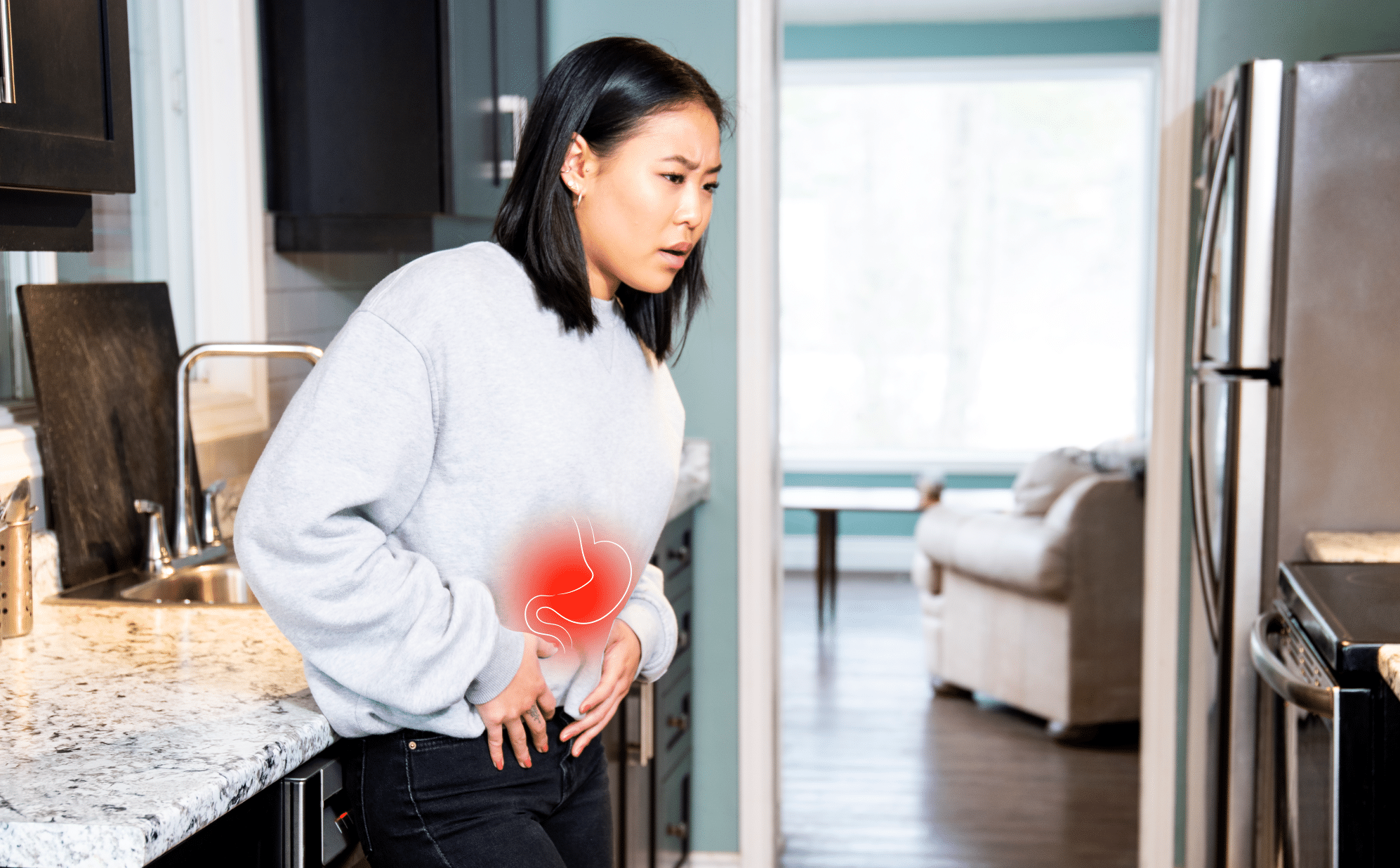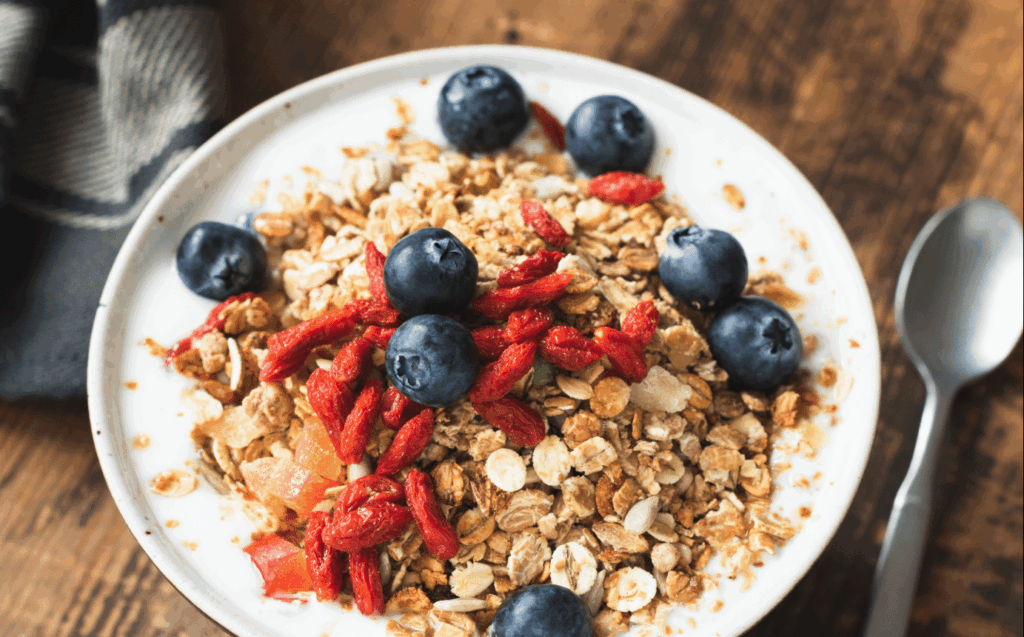Stomach pain is an umbrella term that encompasses many conditions and pain types. It can be sharp or dull, persistent or sudden, confusing or perplexing. OK, those last two are the same thing, but it’s worth repeating how complicated abdominal pain can feel. Here’s how to decode what’s causing your stomach pain—plus, ways to relieve that pain ASAP.
Do you ever feel your stomach clench up when you eat something that disagrees with you? Or maybe you’ve felt it do flips when your Uber driver was a bit too rough with the turns. No matter the exact sensations or cause, stomach pain isn’t fun to deal with. And figuring out what’s causing that discomfort—and how to relieve that stomach pain, fast—isn’t easy. But it can be done.
To shed light on both of these concerns, let’s dive into what different types of abdominal pain may mean, stomach pain relief strategies that actually work, and when it’s time to seek medical attention.
Stomach pain vs abdominal pain
Before we dive into how to relieve stomach pain, let’s get one misconception out of the way: Stomach pain isn’t always linked to the stomach itself. The pain you’re feeling may actually be coming from a different part of the digestive tract.
“We can’t assume right off the bat that the pain in the stomach region is always stomach pain,” says Tamara Duker Freuman, MS, RD, CDN, a registered dietitian specializing in digestive and metabolic diseases. Freuman prefers the term “abdominal pain” as it better captures the overall torso, including the many parts of the digestive tract where you may experience discomfort. Any pain experienced in the chest to the groin falls into this category, she says.
And while abdominal pain seems like it should always be related to digestion, there are other causes outside the digestive system. Appendicitis, menstrual cramps, viral illnesses, kidney stones, and more could be to blame. For the purposes of this article, we’re focusing on the potential gastrointestinal causes that Oshi Health experts diagnose and treat—but those other symptoms, such as menstrual cramps, can also be influenced by GI issues and vice versa, so it’s important to take a whole-health approach with your care.
The anatomy of the abdomen
There’s one more thing to cover before we dive into stomach pain relief, and that’s introducing our cast of characters, otherwise known as the organs of the abdomen:
- Esophagus: Pushes food to your stomach when you eat.
- Liver: Produces a bile that helps your body process fat.
- Gallbladder: Stores and concentrates the bile produced in your liver between meals.
- Stomach: Breaks down proteins in your food before propelling it into your small intestine.
- Pancreas: Produces insulin, glucagon, and enzymes that help digest your food.
- Small intestine: While the stomach initially breaks down your food, most nutrient absorption occurs in your small intestine.
- Large intestine: Stores and concentrates what’s left of your food until it’s time for it to leave your body as waste.
- Appendix: May play a role in immunity or gut health, though researchers are unsure if that role exists or what exactly it is.
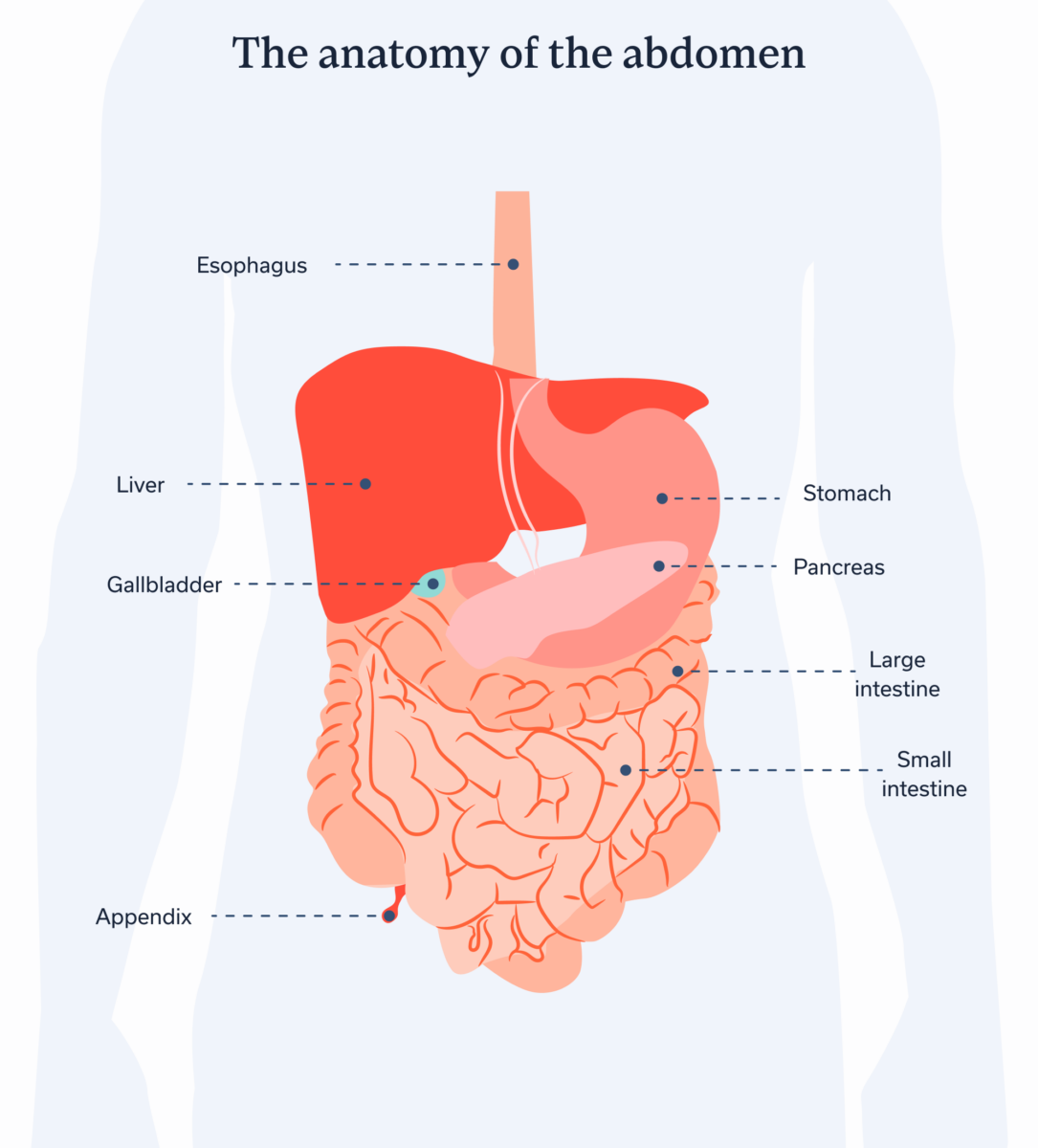
Common causes of upper stomach pain
Usually, pain in the upper stomach is associated with the esophagus, liver, gallbladder, or stomach. Pain in these spots of the upper abdomen might be caused by different medical conditions, though these aren’t hard and fast rules.
Heartburn or chest pain
When someone experiences heartburn or chest pain, there may be a problem with their esophagus—and that problem is often acid reflux or gastroesophageal reflux disease (GERD). GERD and acid reflux occur when food and secretions of the GI tract end up going the wrong way—back up your esophagus rather than down to the stomach. This U-turn can cause pain in the chest region. Many people describe GERD and acid reflux as a “burning sensation”—though some people experience chest pain without the burning sensation. They can also be accompanied by a feeling like you’ve got food stuck in your chest and/or nausea.
Pain below the chest, but above the belly button
If abdominal pain is below your chest but above your belly button, indigestion may be to blame. Twenty five percent of Americans experience indigestion (sometimes referred to as dyspepsia or a stomachache) each year, meaning most of us have probably had at least one run-in with this sensation.
Unlike GERD, indigestion isn’t a diagnosable condition. Instead, it’s either just a passing sensation or a symptom of a viral illness or a larger digestive problem. It can also be a sign of stomach cancer (but before you panic, know this is rare!). More often, chronic indigestion is associated with gastritis (irritated or inflamed stomach lining) and peptic ulcers (a sore in the stomach lining). And we say chronic indigestion for a reason. One-off or occasional indigestion probably isn’t cause for concern and may be due to something you ate; indigestion that keeps popping up or is persistent points to a potential underlying condition.
Freuman notes that peptic ulcers are trickier to pinpoint than gastritis, since they can sometimes cause lower stomach pain, too. Peptic ulcer pain can be sharp or dull, persistent or sporadic, making it even trickier to diagnose.
Abdomen pain on your upper right side
If the pain is in your upper right abdomen, gallstones may be the culprit. Gallstones occur when there’s bile buildup in the gallbladder, triggering an attack. We often feel these attacks as pain in the upper right abdomen, which can last for several hours. Attacks are more likely after a heavy meal or in the evening.
Gallbladder attack pain typically improves when the stones have dislodged, either to pass through the digestive tract or remain in the cystic duct without causing total obstruction. With the second, they have yet to completely pass.
And if you’re wondering how long that might take, it’s usually a couple hours. If it lasts longer, there’s a chance of developing additional gallbladder complications.
Abdomen pain on your upper left side
Pain in your upper left side of the stomach has several potential causes: gastritis, GERD, and, in rare cases, acute pancreatitis. This upper-right abdomen pain typically isn’t a solo act, either; other symptoms that may appear in tandem include pain in other parts of the stomach, bloating, severe vomiting, hiccups, indigestion, a swollen abdomen, and an inability to tolerate liquids, such as water or juice.
How to relieve upper stomach pain
If you’re experiencing upper abdominal pain that lasts more than 24-48 hours, it requires medical attention. For most pain, making an appointment with a primary care provider will suffice. If necessary, they’ll refer you to a gastrointestinal (GI) provider. Or, you can go directly to a GI provider who will diagnose what’s causing the pain and create a treatment plan unique to you.
However, if that pain is accompanied by a fever, chills, jaundice (yellowing of the skin), brownish urine, nausea, or vomiting, head straight to the ER. Pain that presents only on one side is more dangerous than a full-torso ache, and may also call for an emergency medical visit.
How to relieve upper stomach pain immediately
There are things you can try to relieve upper abdominal pain fast, though the most effective approach will depend on the type of pain.
- For acid reflux and GERD, Freuman recommends avoiding spicy foods and alcohol, as well as eating smaller meals every three or four hours instead of larger ones three times a day.
- Gastritis or peptic ulcers may feel better after you eat, advises Freuman. (But you’ll want to avoid acidic foods and drinks that contain caffeine.)
It is important to note that there aren’t any quick fixes for gallbladder pain or pancreatitis (which often require immediate medical attention), though a low fat diet and avoiding alchol may help.
Common causes of lower stomach pain
Pain in the lower abdomen can also present in different ways. However, unlike upper abdominal pain, which is often location-dependent, diagnosing lower abdominal pain typically relies more on the accompanying symptoms.
Lower stomach pain, gas, and bloating
Lower abdominal pain plus gas or bloating may point to an issue with the digestive tract. But the specific cause of that issue can vary. It could just be something you ate, or an underlying condition like irritable bowel syndrome (IBS), inflammatory bowel disease (IBD), or diverticulitis. When bloating, gas, and lower stomach pain are persistent, consult a healthcare provider about the potential cause.
Lower stomach pain and cramping
“Are you experiencing cramping and pain in your lower abdomen? This may or may not be digestion-related,” explains Freuman. “To determine whether it is, look at how you feel after a bowel movement. Crampy pain that feels better when you poop is often IBS or constipation-related pain.”
If that pain doesn’t feel better after pooping, the cause may not be gastrointestinal. There are many non-GI related potential causes of lower stomach pain and cramping, including menstrual cramps, ruptured ovarian cysts, and urinary tract infections, to name a few.
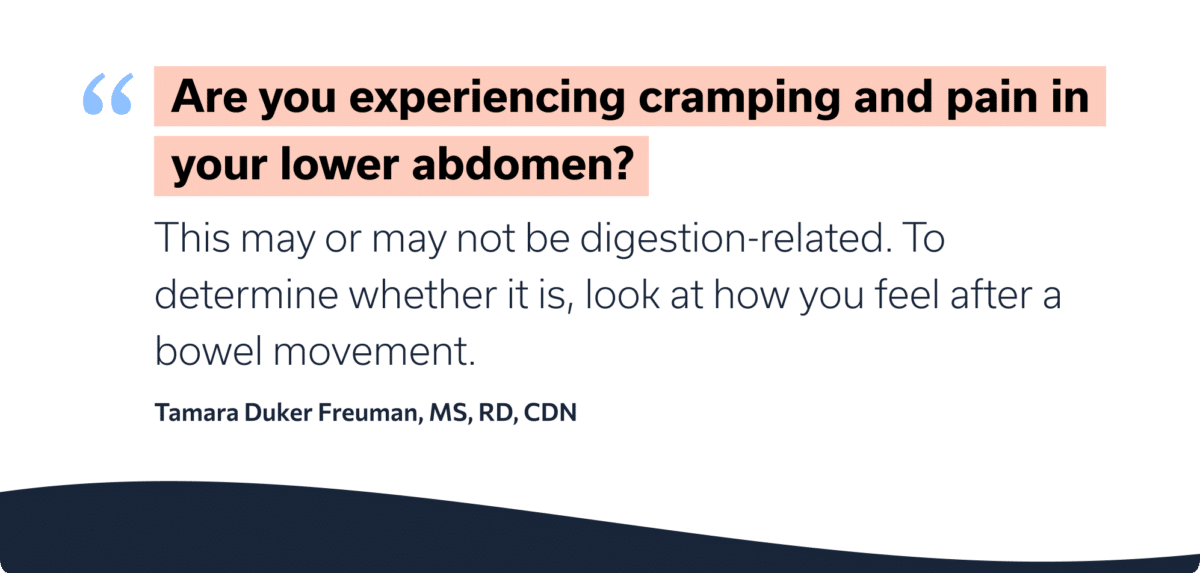
Pain in the middle of the stomach to the lower right side
Sharp, severe pain on your right side, between the belly button and the hip bone, is a cause for concern because it may be indicative of appendicitis. Typically, this pain is accompanied by vomiting, a low-grade fever, nausea, and difficulty eating. Because appendicitis is serious, contact emergency services about any pain concentrated in the lower right-hand side of your belly.
While lower right side pain like this isn’t always due to appendicitis, and there are conditions like a ruptured ovarian cyst or ectopic pregnancy that can mimic appendicitis pain (which medical professionals have labeled as “pseudoappendicitis”), you should seek medical attention regardless, since only a qualified health professional can diagnose the actual cause.
How to relieve lower stomach pain
If you’re constipated and experiencing cramping and abdominal pain, consider drinking more water, moving your body (moderate or light exercise works best), and adjusting your fiber intake. And we’re saying adjust, not increase, for a reason: Contrary to popular belief, combating constipation isn’t always about adding more fiber to your diet. Instead, it’s about finding the right balance of fiber type and quantity for you. Freuman explains, “Some people are constipated because they eat too much fiber, some because they don’t eat enough, and some people eat an imbalance of fiber.” A GI registered dietitian can help you determine what fiber adjustments may work best for you.
For gassy abdominal pain, Freuman often recommends massaging your belly for instant relief, especially after a meal. Movement can also help, but keep any exercise light when in pain (think a walk around the park, not a CrossFit class). A heating pad or warm water bottle may also provide some relief.
And remember: If that pain is exclusive to your lower right side, head to the emergency room so a doctor can check if it’s appendicitis.
Common mistakes to avoid
There are a lot of myths around abdominal pain. Case in point: We often refer to it as “stomach pain” when there are many different organs that could be responsible.
As you may imagine, not all advice on how to stop stomach pain is relevant to every scenario. If you ask a family member for a solution, they may suggest drinking prune juice or taking over-the-counter antacids. These solutions may work for certain complaints, but they won’t address all types of abdominal pain.
While advice from friends and family (and even complete strangers on the internet) often comes with the best of intentions, working with a qualified medical professional to get an official diagnosis—and to develop a customized management plan—is more likely to help you find the lasting relief you seek.
Stomach pain relief tips for different situations
In a coffee shop, some guests linger over a laptop for hours while others grab to-go coffee. Stomach pain works the same—sometimes, it camps out (with or without the Wi-Fi password) and sometimes it’s just passing through.
No matter which type of pain you experience, some relief tactics can work for both kinds. Remember, though: Any lingering pain needs medical attention, as shown in the handy chart below.
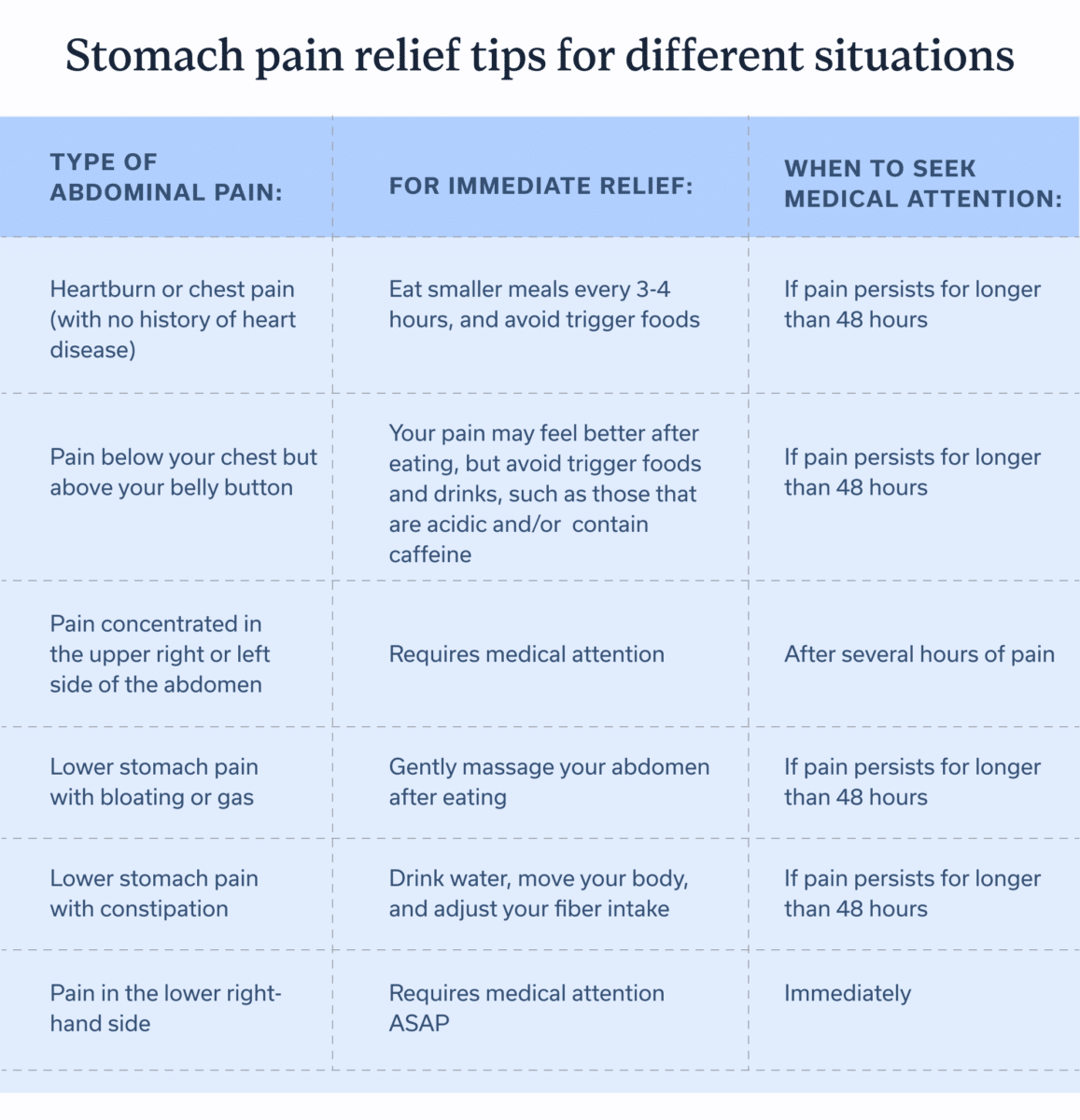
When to seek medical attention for stomach pain
If you’re experiencing persistent stomach pain that lasts more than 24 to 48 hours, you should see a healthcare provider. You may also want to visit a GI provider if you experience chronic (insert: persistent or recurring):
- Bloating
- Constipation
- Diarrhea
- GERD or heartburn
- Loss of appetite
- Nausea or vomiting
This provider can help you determine if your abdominal pain is digestion-related or stems from some other cause. If it’s digestive, they may prescribe over-the-counter treatment or lifestyle changes. Freuman adds that if this first line of defense doesn’t work, your provider may order diagnostic tests to determine the exact cause of abdominal pain.
Meet Oshi's digestive health experts
An integrated team of GI specialists, working together for you
Our expert gastroenterologists, GI providers, registered dietitians, and gut-brain specialists are leaders in their fields, with advanced education and training in gastroenterology. Our comprehensive team approach is personalized to meet your unique needs and address the root cause of your symptoms.
When abdominal pain isn’t digestive in nature, a provider will be able to refer you to the right specialist, such as an OB/GYN for persistent menstrual pain or a urologist if your provider suspects kidney stones.
Certain symptoms may require immediate medical attention, including:
- Blood in stool
- Debilitating abdomen pain
- Difficulty breathing or chest pain
- Fever
- Pain concentrated in your upper left abdomen, which could mean pancreatitis
- Severe pain in your upper right abdomen, which could be a sign of gallstones or a gallbladder attack
- Sudden, sharp pain in your lower right abdomen, which could indicate appendicitis
- Severe or long-term vomiting
Final thoughts
While we wish stomach pain was easy to treat, it’s a nuanced issue and treatment may not always be straightforward. The best diagnosis and treatment for you will depend on whether your stomach pain comes and goes in waves, if it’s sharp or dull, and whether it’s even in your stomach at all.
When researching how to relieve stomach pain, keep in mind:
- Abdominal pain varies: Not all “stomach pain” occurs in the stomach. And there are a plethora of reasons for abdominal pain, some of which are digestive. A medical professional can diagnose what’s causing your pain.
- Pain relief depends on pain type: The type of pain, location of the pain, and accompanying symptoms should help guide your pain relief strategies. Avoiding spicy foods may relieve pain in your chest, for example, but it probably won’t affect menstrual pain.
- Seek medical attention: Stomach pain isn’t something you should navigate alone. If your symptoms persist longer than 24-48 hours or are severe, consult a qualified GI provider. And, as outlined earlier, there are certain instances where immediate medical attention may be warranted.
If you’re looking for a GI provider, consider the team at Oshi Health. Our multidisciplinary team of GI experts takes a whole-person approach, designing unique treatment plans that are tailored to each individual.
Frequently Asked Questions (FAQs)
-
The solution for your upper stomach pain will depend on the cause. If the pain feels like heartburn, eat smaller meals and avoid spicy foods, alcohol, and caffeine. You may also want to limit caffeine if you’re experiencing pain below the chest but above the belly button. For this pain, referred to as indigestion, eating may help relieve it, so long as that meal or snack isn’t acidic.
-
If the top of your stomach hurts, there are various potential causes, including acid reflux and GERD, gallstones passing, gallbladder complications, pancreatitis, or indigestion. A GI provider can help determine what’s causing your upper abdominal pain.
-
The best position depends on the type of stomach pain. For stomach pain with bloating, moving around may help relieve stomach pain. Pain caused by GERD may feel better when sleeping on your left side. For more tailored advice, ask a healthcare provider for the best position based on your symptoms.
-
Gastric pain relief depends on where in the abdomen the pain is located, and whether you’re experiencing other symptoms. For heartburn or chest pain, avoid big meals and food triggers. If you’re experiencing pain below the chest but above the belly button, eating may help. Gentle movement, adjusting fiber intake, and drinking water may help with lower abdominal pain. If the pain is concentrated in the upper or lower right side of the abdomen or in the upper left side of the abdomen, seek immediate medical attention, since this may be a gallbladder complication, pancreatitis, or appendicitis.
Oshi is your partner in digestive health
Feel like your digestive concerns are running your life? You’re not alone—and we’re here to help you find lasting relief.
Oshi Health GI providers, gut-brain specialists, and registered dietitians work together to address the root cause of your symptoms and find solutions that actually work for you.
Whether you’re dealing with chronic digestive issues or unpredictable symptom flare-ups, our GI specialists deliver:
✔ Personalized care plans tailored to your lifestyle
✔ Science-backed strategies to calm your gut
✔ Compassionate, whole-person care
✔ And so much more!
Ready to take control of your gut health?


